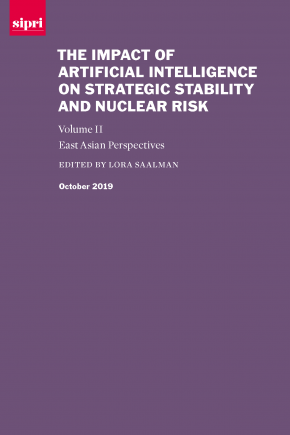 This edited volume is the second of a series of three. They form part of a SIPRI project that explores regional perspectives and trends related to the impact that recent advances in artificial intelligence could have on nuclear weapons and doctrines, as well as on strategic stability and nuclear risk. This volume assembles the perspectives of 13 experts from East Asia, Russia and the United States on why and how machine learning and autonomy may become the focus of an arms race among nuclear-armed states. It further explores how the adoption of these technologies may have an impact on their calculation of strategic stability and nuclear risk at the regional and transregional levels.
This edited volume is the second of a series of three. They form part of a SIPRI project that explores regional perspectives and trends related to the impact that recent advances in artificial intelligence could have on nuclear weapons and doctrines, as well as on strategic stability and nuclear risk. This volume assembles the perspectives of 13 experts from East Asia, Russia and the United States on why and how machine learning and autonomy may become the focus of an arms race among nuclear-armed states. It further explores how the adoption of these technologies may have an impact on their calculation of strategic stability and nuclear risk at the regional and transregional levels.
Contents
1. Introduction
Part I. The technologies and dynamics of artificial intelligence and nuclear risk
2. Artificial intelligence and its impact on weaponization and arms control
3. The role of artificial intelligence in deterrence in cyberspace
4. Integration of neural networks into hypersonic glide vehicles
5. Applications of machine learning in North Korea and South Korea
6. Military developments in artificial intelligence and their impact on the Korean peninsula
7. Artificial intelligence and military advances in Russia
8. Exploring artificial intelligence and unmanned platforms in China
Part II. The future of arms control and strategic stability under artificial intelligence
9. The impact of military artificial intelligence on warfare
10. The shaping of strategic stability by artificial intelligence
11. Regulatory frameworks for military artificial intelligence
12. The environmental impact of nuclear-powered autonomous weapons
13. East Asian security dynamics as shaped by machine learning and autonomy
14. Arms control and developments in machine learning and autonomy
Conclusions
15. The impact of artificial intelligence on nuclear asymmetry and signalling in East Asia
ABOUT THE AUTHOR(S)/EDITORS
Dr Lora Saalman is an Associate Senior Fellow within SIPRI’s Armament and Disarmament and Conflict and Peace research areas and a Senior Fellow in the Global Cooperation in Cyberspace Program at the EastWest Institute.
No comments:
Post a Comment